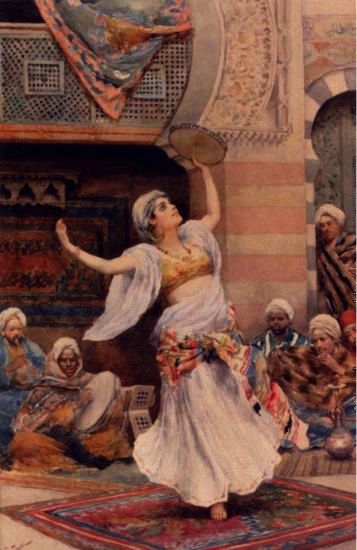Danseuse Tambourin à Gauche, A Bisque Porcelain Sculpture
Designed by Agathon Leonard for Sèvres, circa 1900
Signed SEVRES HR and No. 6
19 7/8 in (50.5 cm) high
cf. Ingelore Böstge, Agathon Léonard, Le Geste Art Nouveau, 2003, pp.40, 42, 44-45, 52
E. Baumgart, La Manufacture Nationale de Sèvres a l'Exposition Universelle de 1900
19 7/8 in (50.5 cm) high
cf. Ingelore Böstge, Agathon Léonard, Le Geste Art Nouveau, 2003, pp.40, 42, 44-45, 52
E. Baumgart, La Manufacture Nationale de Sèvres a l'Exposition Universelle de 1900
At the 1900 Paris Exposition Universelle, the Sèvres Porcelain Manufactory caused a sensation with a table centrepiece of biscuit porcelain, comprising 15 statuettes dancing with veils. The technical prowess of the delicate, almost translucent folds in drapery was made possible through the development of a new, hard china clay of exceptional resistance. The novelty of the subject, the quality of the statuettes and their harmonious and dynamic composition, impressed the public. The model for this dancer was taken from that table centrepiece.
When Alexandre Sandier was appointed to the post of artistic director in 1896, the Sèvres factory revitalised its production. In 1897, at the Salon de la Société nationale des Beaux-Arts Sandier saw 'Ten models depicting a dance with 'scarves' and reliefs made of terracotta which pre-figured the decoration of a 'dance centre'. He contacted the artist, Agathon Léonard, and asked him to modify and adapt his figures for a table centrepiece. This represented a significant break with the traditional centrepiece of the 18th century and introduced the fresh aesthetic of flowing lines and arabesques typical of Art Nouveau style.
We know from the factory archives that 125 copies of this model in two different sizes were sold between 1901 and 1923. Its continued success demonstrates the long-standing popularity of Art Nouveau.
Other examples of this model are held in the collections of the Musée d'Orsay, the Bröhan-Museum, The Art Institute of Chicago, the Museum für Kunst und Gewerbe, the Victoria and Albert Museum, the Hermitage, and the Musée national de Céramique.
When Alexandre Sandier was appointed to the post of artistic director in 1896, the Sèvres factory revitalised its production. In 1897, at the Salon de la Société nationale des Beaux-Arts Sandier saw 'Ten models depicting a dance with 'scarves' and reliefs made of terracotta which pre-figured the decoration of a 'dance centre'. He contacted the artist, Agathon Léonard, and asked him to modify and adapt his figures for a table centrepiece. This represented a significant break with the traditional centrepiece of the 18th century and introduced the fresh aesthetic of flowing lines and arabesques typical of Art Nouveau style.
We know from the factory archives that 125 copies of this model in two different sizes were sold between 1901 and 1923. Its continued success demonstrates the long-standing popularity of Art Nouveau.
Other examples of this model are held in the collections of the Musée d'Orsay, the Bröhan-Museum, The Art Institute of Chicago, the Museum für Kunst und Gewerbe, the Victoria and Albert Museum, the Hermitage, and the Musée national de Céramique.
















